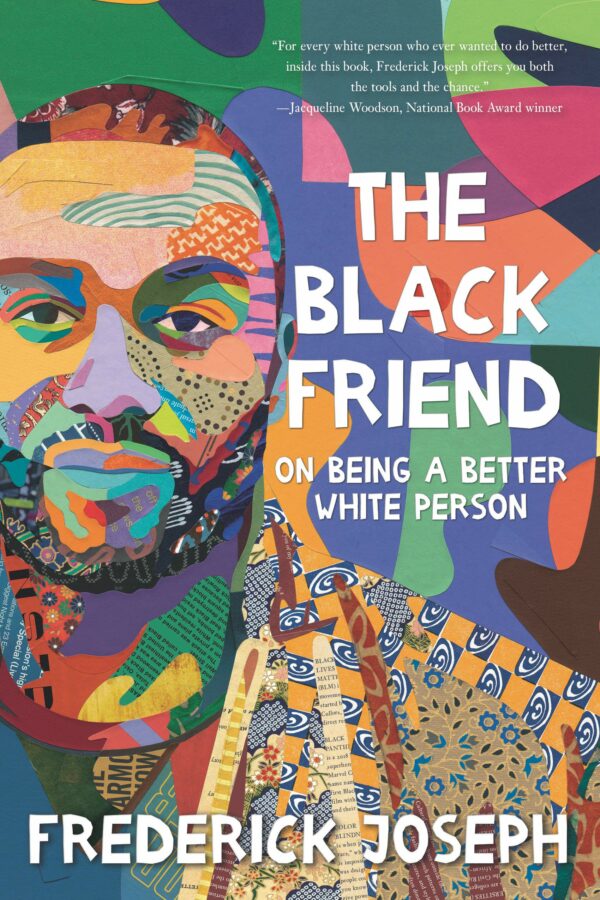This review of “The Black Friend: On Being a Better White Person” is sponsored by Candlewick Press.
How does one become an antiracist? This question has been addressed and answered to varying degrees for years but was brought up with a renewed sense of urgency since the news of the murders of George Floyd, Breonna Taylor, and sadly too many others at the hands of the police.
One of the latest books to discuss systemic racism and social injustice is Frederick Joseph’s The Black Friend: On Being a Better White Person. Joseph’s aim, as the titular Black friend, is to address and hold white and non-Black readers accountable for their ignorance and racially offensive behavior and teach them how to become aware of their racist biases and actively work to solve these problems and stop others who perpetuate racism. In other words, he lays the foundations for his readers to know and identify racism in hopes that they ultimately learn how to use this knowledge to become antiracists.

Joseph wants to help create a better world for everyone, particularly for Black people, and in doing so, he crafts a candid and affecting book that addresses racism and social injustice through the lenses of his personal experiences, interviews with notable writers and activists, and pop culture and media references.
The Black Friend is a quick read, yet far from being a light read. Each chapter focuses on a different topic involving racial injustice. Whether it’s learning how to confront racist family members or understanding the difference between cultural appropriation and appreciation, Joseph navigates each topic with care, sincerity, and utter frankness. He tells stories from his personal history, sharing his experience of being one of the few Black kids at his mostly white high school. He’s honest about his own past failings—moments where he felt he should have said something but didn’t and allowed racist behavior to happen unquestioned.
While each chapter tackles its own topic with its set of anecdotes and interviews, reading it in the order in which the book lays it out allows the reader to grow with Joseph. He doesn’t tell his stories in chronological order, but each story builds upon the previous one. It effectively showcases just how insidious and rampant racist behavior is, as well as how complex it can be. The topics he discusses are always intersecting, and his book is a great example of why we can’t cherry-pick the kind of work we do to stop racism. We need to do all of this work.
Along with Joseph’s experiences, the book has semi-interactive elements, such as an “Encyclopedia of Racism” that defines racism-related terms, which Joseph references often throughout the book. There are also asides embedded throughout the chapters when Joseph pauses, stops, or rewinds to expand upon a detail, guide the reader to a resource, or directly tell the reader to do something. These asides are used pretty liberally; some are funny, some are necessary, and many are both. They bring out a lot of Joseph’s personality.
However, I wished Joseph was more selective of how he used them, especially the asides that point out the reader’s age. This book is written for young adult readers, many of whom were born in the 2000s, and Joseph mentions many early Internet things from the late 90s and early 2000s. While I understand that young readers might not catch or understand every pop culture reference, I didn’t think we needed to pause the momentum of the story to explain some of them. With that said, the majority of the notes are helpful guiding tools; I know that I’ll be referencing the cultural appropriation one in the future.
I would be remiss to not discuss the interviews, which were one of my favorite parts of this book. Joseph’s voice is strong and his experiences are enlightening, yet by adding other voices, it brings to light the intersection of race with many other pressing topics. He speaks with writers and activists, like Angie Thomas, April Reign, Rabia Chaudry, Xorje Olivares, Tarell Alvin McCraney, and others. His interview with Moonlight screenwriter McCraney was particularly revelatory and provides another moment when Joseph gets especially candid and honest with the reader about how he himself is also still learning. It’s an incredible teaching moment not just for Joseph but for us as readers—as people who want to be better.
The Black Friend is not the type of book you read and then pat yourself on the back for reading it. In fact, I can imagine Frederick Joseph reaching through the pages and giving you a good shake if that notion of performative wokeness passes through your head. This is the book that tells you plain and simple what you need to know and do to be an antiracist. In a letter at the beginning of the book, Joseph says he’s tired, and after reading this, I could feel that for him and the Black community who share similar experiences. Joseph extends a service to white readers that he didn’t need to do, and in a perfect world, it’s a service he shouldn’t have to do. The most we can do is not just be grateful that he did but listen to what he said and act.
The Black Friend: On Being a Better White Person by Frederick Joseph was released on December 1, 2020.







